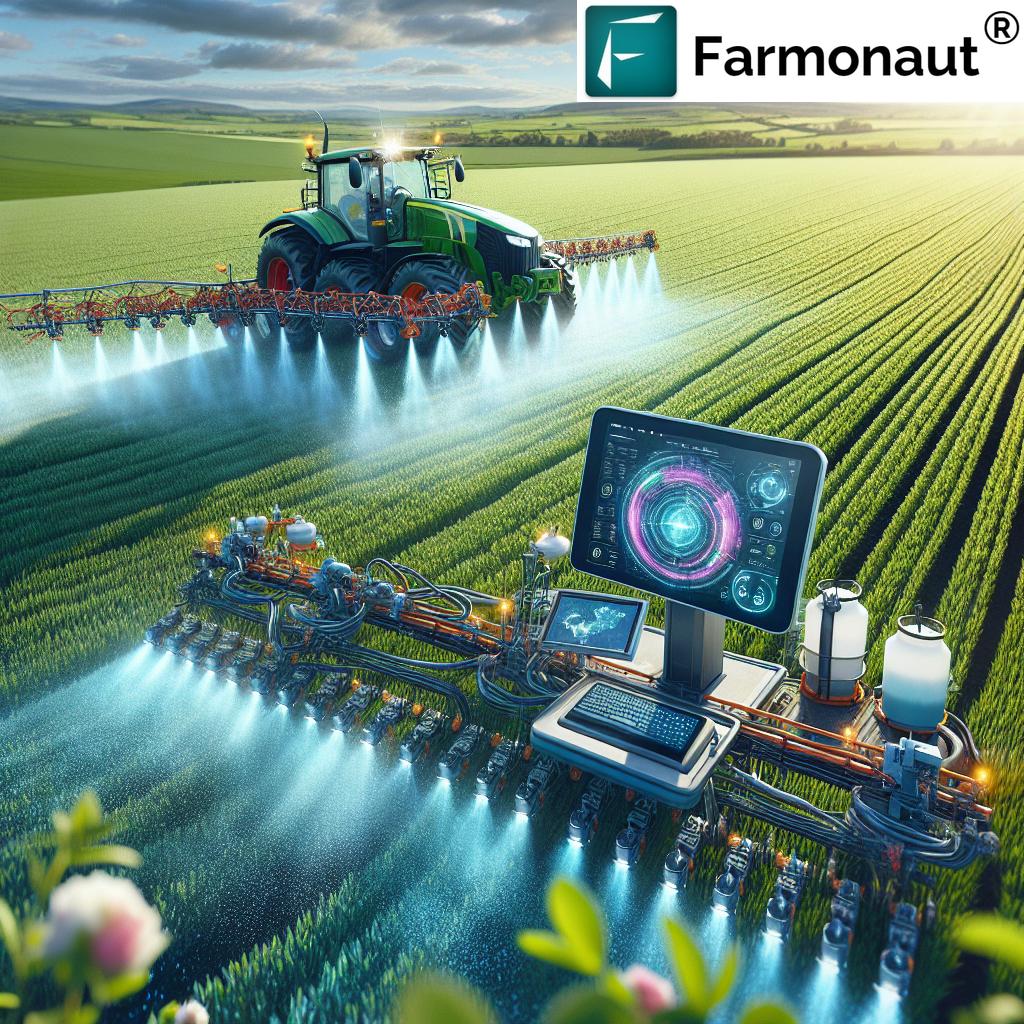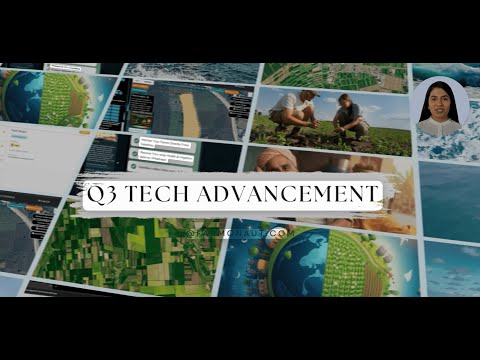Revolutionizing Scottish Agriculture: How Precision Technology and GIS are Transforming Sustainable Farming Practices
“Scottish farmers using precision agriculture technology have seen up to 20% increase in crop yields.”
Welcome to a journey through the transformative landscape of Scottish agriculture, where cutting-edge technology and sustainable practices are reshaping the future of farming. In this comprehensive exploration, we’ll delve into how precision agriculture technology, GIS applications, and innovative farming techniques are revolutionizing the agricultural sector in Scotland and beyond.
The Dawn of Precision Agriculture in Scotland
Scotland’s rich agricultural heritage is entering a new era, one where data-driven decisions and technological advancements are at the forefront. Precision agriculture technology is no longer a futuristic concept but a present-day reality for many Scottish farmers. From the rolling hills of the Highlands to the fertile lowlands, we’re witnessing a transformation that promises to enhance productivity, sustainability, and rural prosperity.

Crop Health Monitoring: A Revolution in Plant Care
One of the most significant advancements in Scottish agriculture is the adoption of remote sensing for crop health monitoring. This technology allows farmers to keep a vigilant eye on their fields without setting foot in them. Here’s how it works:
- Satellite imagery captures multispectral data of farmlands
- Advanced algorithms analyze this data to assess crop health
- Farmers receive real-time updates on vegetation health indices (NDVI)
- Early detection of crop stress, disease, or pest infestations becomes possible
By leveraging these insights, Scottish farmers can take proactive measures to address issues before they escalate, leading to improved yields and reduced use of pesticides.
Smart Irrigation Systems: Optimizing Water Usage
“GIS-powered farm management software has helped reduce water usage by 30% in some Scottish farms.”
Water management is crucial in Scottish agriculture, especially in areas prone to unpredictable weather patterns. Smart irrigation systems are revolutionizing how farms use this precious resource:
- Soil moisture sensors provide real-time data on field conditions
- Weather forecasts are integrated to predict water needs
- Automated systems deliver precise amounts of water to crops
- Reduction in water waste and improved crop health
These systems not only conserve water but also contribute to better crop quality and yield, showcasing how technology can drive both productivity and sustainability in Scottish farming.
The Power of Agricultural GIS Applications
Geographic Information Systems (GIS) have become indispensable tools in modern Scottish agriculture. These applications offer a wealth of benefits:
- Precise mapping of field boundaries and crop types
- Analysis of soil composition and fertility across different areas
- Identification of optimal planting zones for various crops
- Tracking of machinery movements for efficient field operations
By harnessing the power of GIS, Scottish farmers can make informed decisions about crop rotation, resource allocation, and land use, leading to more sustainable and profitable farming practices.
Farm Management Software: The Digital Revolution in Agriculture
The advent of comprehensive farm management software has brought about a digital revolution in Scottish agriculture. These platforms offer a centralized hub for all farming operations:
- Crop planning and monitoring
- Inventory management for seeds, fertilizers, and equipment
- Financial tracking and budgeting
- Integration with precision agriculture tools for data-driven insights
By adopting these software solutions, Scottish farmers are streamlining their operations, reducing paperwork, and gaining valuable insights into their farm’s performance. This digital transformation is not just about efficiency; it’s about empowering farmers with the tools they need to make smarter, more sustainable decisions.
Soil Fertility Management: The Foundation of Sustainable Farming
Maintaining healthy, productive soils is at the heart of sustainable agriculture in Scotland. Advanced soil fertility management tools are helping farmers optimize their soil health:
- Precision soil sampling and analysis
- Variable rate fertilizer application based on soil needs
- Tracking of soil organic matter and nutrient levels over time
- Integration with crop rotation plans for long-term soil health
These tools enable Scottish farmers to nurture their soil, reduce fertilizer waste, and ensure long-term productivity of their land.

Agricultural Drone Technology: A Bird’s Eye View of Farming
Drones are increasingly becoming a common sight in Scottish skies, offering farmers unprecedented views of their fields. These aerial assistants provide numerous benefits:
- High-resolution imagery for detailed crop assessment
- Thermal imaging to detect irrigation issues or plant stress
- Precision application of pesticides and fertilizers
- Livestock monitoring in remote or expansive areas
The adoption of drone technology is enabling Scottish farmers to monitor and manage their land with greater precision and efficiency than ever before.
Data-Driven Farming Decisions: The Future of Agriculture
The true power of precision agriculture lies in its ability to inform decision-making. Scottish farmers are now equipped with a wealth of data to guide their farming practices:
- Historical yield data to inform crop selection and rotation
- Real-time market information for optimal harvest timing
- Predictive analytics for pest and disease management
- Resource optimization based on comprehensive farm data
This data-driven approach is transforming Scottish agriculture from an intuition-based practice to a science-backed industry, leading to more sustainable and profitable farming operations.
Sustainable Farming Practices: A Commitment to the Future
The adoption of precision agriculture technology in Scotland goes hand in hand with a commitment to sustainable farming practices. Here’s how technology is supporting sustainability:
- Reduced use of water, fertilizers, and pesticides through precision application
- Minimized soil erosion through targeted tillage and cover cropping
- Enhanced biodiversity through precision conservation practices
- Reduced carbon footprint through optimized machinery use and resource management
These sustainable practices not only benefit the environment but also contribute to the long-term viability of Scottish farms.
Rural Diversification: Expanding Horizons in Scottish Agriculture
Technology is not just improving traditional farming; it’s also opening new avenues for rural diversification in Scotland:
- Agritourism powered by virtual and augmented reality experiences
- Precision forestry for sustainable timber production
- Smart greenhouses for year-round crop production
- On-farm renewable energy generation and management
These diversification strategies are helping Scottish farmers create additional revenue streams and build resilience in the face of changing agricultural markets.
The Role of Farmonaut in Scottish Agriculture
In the realm of precision agriculture, Farmonaut stands out as a pioneering force, offering advanced satellite-based farm management solutions. Their platform provides valuable services that align perfectly with the needs of Scottish farmers:
- Real-time crop health monitoring using satellite imagery
- AI-based advisory systems for personalized farm management
- Blockchain-based traceability for supply chain transparency
- Resource management tools for optimized farming operations
Farmonaut’s technologies are making precision agriculture more accessible and affordable for farmers across Scotland, regardless of farm size or type.
Explore Farmonaut’s solutions:
The Future of Scottish Agriculture: Trends and Predictions
As we look to the future, several trends are shaping the landscape of Scottish agriculture:
- Increased adoption of AI and machine learning in farm management
- Integration of IoT devices for comprehensive farm monitoring
- Development of climate-resilient crop varieties using precision breeding techniques
- Expansion of vertical farming in urban and peri-urban areas
- Greater emphasis on circular economy principles in agricultural practices
These trends suggest a future where Scottish agriculture is not only more productive but also more sustainable and resilient in the face of global challenges.
Overcoming Challenges in Precision Agriculture Adoption
While the benefits of precision agriculture are clear, there are challenges that Scottish farmers face in adopting these technologies:
- Initial investment costs for equipment and software
- Need for technical skills and training
- Data privacy and security concerns
- Ensuring reliable internet connectivity in rural areas
Addressing these challenges will be crucial for the widespread adoption of precision agriculture technologies across Scotland.
The Role of Government and Industry Support
The Scottish government and agricultural industry bodies play a vital role in supporting the transition to precision agriculture:
- Providing grants and subsidies for technology adoption
- Investing in rural broadband infrastructure
- Offering training and educational programs for farmers
- Developing policies that incentivize sustainable farming practices
This support is essential in ensuring that Scottish agriculture remains competitive and sustainable in the global market.
Precision Agriculture Technologies and Their Impact on Scottish Farming
| Technology | Description | Benefits | Adoption Rate in Scotland (Estimated) |
|---|---|---|---|
| Remote Sensing for Crop Health Monitoring | Uses satellite and drone imagery to assess crop health | Early detection of crop stress, disease, and pests | 40% |
| Smart Irrigation Systems | Automated water management based on soil and weather data | Water conservation and improved crop yields | 30% |
| Agricultural GIS Applications | Mapping and analysis of farm data for informed decision-making | Optimized resource allocation and land use planning | 50% |
| Farm Management Software | Comprehensive digital platforms for farm operations management | Improved efficiency and data-driven decision making | 60% |
| Soil Fertility Management Tools | Precision soil analysis and variable rate fertilizer application | Optimized soil health and reduced fertilizer waste | 45% |
| Agricultural Drone Technology | Aerial imaging and precision application of inputs | Detailed crop monitoring and targeted interventions | 25% |
Case Studies: Success Stories from Scottish Farms
While we don’t have specific case studies from Farmonaut, there are numerous success stories from Scottish farms that have embraced precision agriculture:
- A dairy farm in Aberdeenshire increased milk production by 15% through precision feeding and health monitoring
- An arable farm in the Lothians reduced pesticide use by 30% using drone-based crop monitoring
- A highland sheep farm improved lambing rates by 10% with the help of GPS tracking and health monitoring systems
These examples demonstrate the tangible benefits that precision agriculture can bring to various types of Scottish farms.
The Global Context: Scotland’s Place in International Agriculture
Scotland’s adoption of precision agriculture technology places it at the forefront of global agricultural innovation. The country’s experiences and successes offer valuable lessons for farmers worldwide, particularly in regions with similar climatic challenges.
Moreover, Scottish agricultural exports benefit from the traceability and quality assurance that precision farming provides, enhancing the country’s reputation in international markets.
Bridging the Gap: Technology and Traditional Farming Wisdom
It’s important to note that the adoption of precision agriculture in Scotland doesn’t mean abandoning traditional farming wisdom. Instead, it’s about bridging the gap between time-honored practices and cutting-edge technology. The most successful Scottish farmers are those who blend generations of farming knowledge with the insights provided by precision agriculture tools.
The Role of Education and Training
As precision agriculture technology continues to evolve, education and training become increasingly important. Scottish agricultural colleges and universities are adapting their curricula to include courses on:
- GIS and remote sensing applications in agriculture
- Data analysis and interpretation for farm management
- Precision equipment operation and maintenance
- Sustainable farming practices in the digital age
These educational initiatives are crucial in preparing the next generation of Scottish farmers for a technology-driven agricultural landscape.
Conclusion: A Bright Future for Scottish Agriculture
The revolution in Scottish agriculture, driven by precision technology and GIS, is transforming farming practices and paving the way for a more sustainable and productive future. From crop health monitoring to smart irrigation systems, from agricultural GIS applications to farm management software, these innovations are empowering Scottish farmers to make data-driven decisions that benefit both their bottom line and the environment.
As we look to the future, it’s clear that the integration of technology in agriculture will only deepen. Scottish farmers who embrace these changes will be well-positioned to thrive in an increasingly competitive and challenging global market. The journey towards fully sustainable and technologically advanced farming is ongoing, but Scotland is undoubtedly at the forefront of this agricultural revolution.
For those looking to be part of this exciting transformation, solutions like Farmonaut offer accessible entry points into the world of precision agriculture. By leveraging these tools and technologies, Scottish farmers can continue to lead the way in sustainable, efficient, and productive farming practices.
FAQ Section
Q: What is precision agriculture technology?
A: Precision agriculture technology refers to farming management practices that use information technology and a wide array of items such as GPS guidance, control systems, sensors, robotics, drones, autonomous vehicles, variable rate technology, GPS-based soil sampling, automated hardware, telematics, and software to optimize crop yields and reduce waste.
Q: How does GIS benefit Scottish agriculture?
A: GIS (Geographic Information Systems) benefits Scottish agriculture by allowing farmers to create detailed maps of their fields, analyze soil composition, plan crop rotations, and optimize resource allocation. It provides a visual representation of farm data that aids in decision-making and long-term planning.
Q: What are some examples of sustainable farming practices in Scotland?
A: Sustainable farming practices in Scotland include precision fertilizer application, integrated pest management, crop rotation, cover cropping, minimal tillage, water conservation through smart irrigation, and the use of renewable energy on farms.
Q: How are drones used in Scottish agriculture?
A: Drones are used in Scottish agriculture for various purposes, including crop health monitoring, precise application of pesticides and fertilizers, soil and field analysis, planting, and livestock monitoring. They provide high-resolution imagery that helps farmers make informed decisions about crop management.
Q: What is the role of AI in modern Scottish farming?
A: AI plays a significant role in modern Scottish farming by analyzing large datasets from various sources (satellite imagery, weather data, soil sensors) to provide insights and predictions. It helps in crop yield prediction, disease detection, automated machinery operation, and personalized farm management advice.
As we conclude this exploration of precision agriculture in Scotland, it’s clear that the future of farming is bright, sustainable, and technologically advanced. By embracing these innovations, Scottish farmers are not just improving their own operations, but are contributing to a more sustainable and food-secure world.
For those interested in learning more about how precision agriculture can benefit their farms, we encourage you to explore the resources and tools available through platforms like Farmonaut. The journey towards a more sustainable and productive agricultural future is one that we must all undertake together.
Explore Farmonaut’s API for developers: Farmonaut API
API Developer Documentation: Farmonaut API Docs
Together, let’s cultivate a future where technology and tradition work hand in hand to create a thriving, sustainable Scottish agricultural sector.






